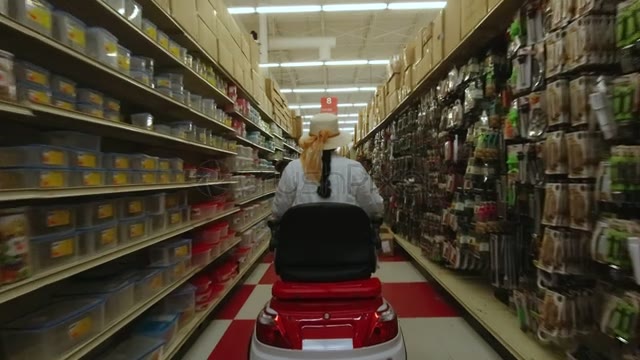Noticing
In a supermarket recently, I passed a woman who was using a motorized shopping cart. I might not have taken notice since she did not seem to need help. But since the pandemic hit, I have been conscious of keeping distance, so I’m more aware of those around me, especially indoors. The woman seemed to be in her fifties, was masked and was wearing a black sweater and dark green pants. She was petite, and the scooter seat was quite low, presumably set that way to make it easy for her to get on and off. As we passed, I happened to glance in the basket affixed to the front of her scooter. There was something about the collection of products that struck me, although for the first minute or so it didn’t quite register why. But as I continued navigating the aisles, I realized what the collection of items in her basket brought to mind.
Several years ago, I taught a course at SUNY called Persuasion and Compliance Gaining. Our primary focus was on the healthcare industry, including the psychology behind ads for health products and pharmaceuticals. But we also explored practices in other industries, for example, how supermarkets place their products throughout the store to encourage shoppers to buy more than they might have intended. For instance, did you ever notice that dairy products (especially milk), fruits and vegetables, and bread are often spread out, almost always on different ends of the store? These are staples on grocery lists, so the strategy is to have consumers walk through as much of the store as possible to get to them.
While on the subject – and I’ll get back to the woman in a moment – the produce is typically close to the entrance. Like everything else about product placement, this is no accident. The colorful displays create a visual appeal, and surveys show that people report feeling good walking through that section. It produces a buoyant feeling that actually heightens our buying impulses, making us more likely to reach for things that might not have been on our shopping list. Fruits and vegetables are also leveraged for their cross-selling potential. For example, strawberries can encourage a shopper to think of buying whipped cream and other berries.
Now, imagine you are heading from the produce section to get milk. Again, in most supermarkets you have to traverse the entire store to get from the produce section at one end to the dairy section on the other. What are the odds you’ll pick up something along the way, something you may not have planned to buy? Pretty good, according to researchers who compile information on consumer behavior. I still have a container of powdered goat’s milk I probably bought for our puppy in 2014 and a jar of lime curd from 2016 sitting on our pantry shelf. I’m not even sure what I was thinking when they made their way from the supermarket shelf to my basket to my pantry.
Another tactic that supermarkets use relates to what attracts our attention. Those who study supermarket psychology know that the expression “eye level is buy level” is right on target. For example, products with the greatest profit potential are typically located on shelves between 3-1/2 and 5 feet from the floor. In fact, some studies show that over 75% of the products that catch our eye are located on those mid-level shelves and over 60% of all the products we buy are located in that range.
The more expensive items tend to be placed on the higher shelves, often way up top. These products don’t sell as much, but since they don’t take up much shelf space, they are not costly for the store to keep. And their presence helps to promote a desired image, for example, that they cater to gourmet tastes as well as to “everyday” grocery needs. The items on those shelves are not ones you’d generally see in Sam’s or Costco. Think vermouth-infused martini olives and something I’d never have believed I’d actually see… until I did: roas ted scorpions!
ted scorpions!
So, back to the woman in the motorized shopping cart. In the basket were boxes of sugary cereals, two packages of Goldfish crackers, and three six-packs of juice boxes. Of course, all her selections could simply have been things she liked. Or maybe she had children at home or was anticipating a grandchild’s visit. Maybe she was picking up a few things for a neighbor. Or maybe I was just reading too much into all this.
Nevertheless, all the things in her basket had one thing in common: All were from the lower shelves. And, of course, it’s common practice for supermarkets to place products that appeal to children on the lower shelves, especially in the cereal, cookie, and snack aisles.
This had me wondering. What if there was a reason for her choices other than personal preference or getting things for her kids or for a neighbor? Upon reflection, I realized that there was nothing from the Appetizing or Deli counters. Might this have something to do with the woman having limited reach?
Might she have had to confine herself to the shelves and departments to which she had easy access? If so, why? Could she be uncomfortable asking others for help? Maybe she was shy or private? Perhaps she didn’t want to impose upon others. What if she had grown so accustomed to seeing only the lower shelves that those now constituted the total universe from which her selections were made. In this way, the upper shelves might have become irrelevant, possibly even invisible, never penetrating her consciousness.
And what might that mean for those of us passing others whom we think might need some help? The answer may be less obvious than one might imagine. I was once on a street corner in NYC, waiting for the light to change. A woman in a wheelchair rolled up alongside, and when the light changed, I asked if she needed a hand crossing the street. She replied, “I’m perfectly fine on my own.” And indeed, she was. Though polite, she said it with conviction, as if to leave no doubt that she and I were no different in terms of capability of crossing streets. And I inferred from her firmness a message that I should think before making certain assumptions. And, indeed, I did make an assumption about her capability. And, based on that, I extended an offer of help. But in so doing, I called attention to what I perceived as different about us, suggesting that I was more able than she. Undoubtedly, she gets that a lot. And even though our intentions may be honorable, our acts have the potential for communicating what she and others in her situation fight for all the time – to be seen and treated in ways that emphasize our sameness, not our differences, to be regarded as able, not powerless, as competent, not needy.
I hope that the woman in the supermarket felt that way, and that the products in her basket didn’t reflect an unwillingness to ask for help. I hope that she would not have hesitated to reach out if she couldn’t reach up for something she wanted.
I have friends who work in various fields of disability services who advise that it can be helpful to ask if someone needs assistance, depending on the circumstances. But, they counsel, be respectful and don’t allow good intentions to deprive the person of his or her agency, of their dignity, of their desire to exercise as much autonomy as they desire. Thus, reading the situation is so critical.
I confess to have noticed others less than I probably should have over the years. Being wrapped up in my own thoughts is no excuse. Nor is being too busy. But there has been something about the pandemic that has made me observe others more and think about them more consciously. The pandemic has taken so much from us. But I’m finding it also reminds us how precious life it.

